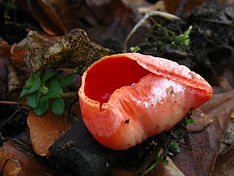Sarcoscypha dudleyi
| Sarcoscypha dudleyi | |
|---|---|
 |
|
| Scientific classification | |
| Kingdom: | Fungi |
| Division: | Ascomycota |
| Class: | Pezizomycetes |
| Order: | Pezizales |
| Family: | Sarcoscyphaceae |
| Genus: | Sarcoscypha |
| Species: | S. dudleyi |
| Binomial name | |
|
Sarcoscypha dudleyi (Peck) Baral (1984) |
|
| Synonyms | |
|
|
| Sarcoscypha dudleyi | |
|---|---|
| Mycological characteristics | |
| smooth hymenium | |
| no distinct cap | |
| hymenium attachment is irregular or not applicable | |
| stipe is bare | |
| ecology is saprotrophic | |
| edibility: inedible | |
Sarcoscypha dudleyi, commonly known as the crimson cup or the scarlet cup, is a species of fungus in the Sarcoscyphaceae family of the Pezizales order. In addition to its main distribution in the central to eastern United States, the fungus has also been recorded once in Bulgaria. It has been frequently confused with Sarcoscypha coccinea, but can be distinguished from this and other related species in Sarcoscypha by differences in microscopic characteristics, such as the presence and number of oil droplets in the spores. The species Molliardiomyces dudleyi is an imperfect form of the fungus that lacks a sexually reproductive stage in its life cycle.
The species was first collected by the botanist William Russell Dudley in October 1888, in Tompkins County, New York. American mycologist Charles Horton Peck, who described it in the 1894 Annual Report of the New York State Botanist, named it Peziza Dudleyi after its discoverer. Peck noted a physical resemblance to P. aurantia (now known as Aleuria aurantia) and P. inaequalis, and said that it could be distinguished from those species by its yellow hymenium and larger spores. Several mycologists have considered the species to be synonymous with S. coccinea. However, as was later pointed out by Harrington (1990), "the importance of fresh material for species diagnosis, especially for noting ascospore guttulation, cannot be overstated. Although I had examined material (dried herbarium specimens) from western North America I was not prepared to recognize that group as a species distinct from the two, large eastern North American species until I saw fresh (living) material." As is the case with many fungi, microscopic differences between similar species can only be accurately determined by examining fresh material. Harrington analyzed herbarium specimens and fresh material of North American specimens of "S. coccinea", and found that both S. dudleyi and S. austriaca were commonly misidentified. These results echoed a similar 1984 analysis of European specimens, performed by Hans-Otto Baral.
...
Wikipedia
